What Is a Technical SEO Audit and Why Does It Matter?
Even the best-written content in the world won’t rank if your website is broken behind
Home » Anchor Text Ratio SEO – Faster Rankings With Less Backlinks
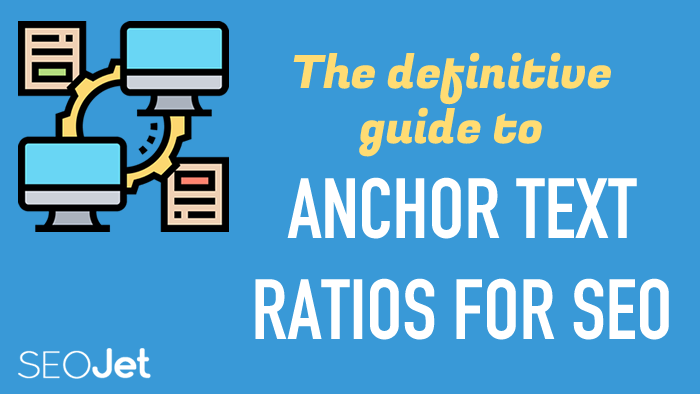
Even the best-written content in the world won’t rank if your website is broken behind
Google redefined the search experience with AI Overviews—a generative AI feature that instantly summarizes answers
Jump to:
1. What Is Anchor Text Ratio SEO? 2. Why Is It Important to Mix Your Anchor Text? 3. The 12 Anchor Text Categories 4. 3 Main Anchor Text Groups 5. What Are The Proper Anchor Text Ratios? 6. Homepage Anchor Text Ratio 7. Inner-page Anchor Text Ratio 8. How You Can Figure Out Competitors Anchor Text Ratio For SEO 9. Anchor Text Ratio Checker 10. Anchor Text Generator 11. Conclusion
Anchor text ratio is the distribution of all the anchor texts in your backlink profile.
In this blog, you’ll learn about the different types of anchor text and how to maintain a natural balance to benefit your SEO.
An organic homepage backlink profile will probably have the majority (75% or more) of their backlinks with the brand name or URL as the anchor text. For us, that would be anchor texts featuring SEOJet or seojet.net.
Blog posts, on the other hand, may include a better mix of keyword to non-keyword anchors in their backlinks.
The important thing to remember is that unnatural backlink profiles can decimate your SEO, so you should spend a lot of time and effort on getting the right ratio.
If you get it right, you have a much better chance of ranking in the top 5 of Google.
So let’s get into setting yourself up for success with anchor text ratios.
You will struggle to rank higher in search results if your anchor text ratio is unnatural. Therefore, it’s important to keep an eye on it as you build new backlinks.
Backlinks play such an important role in SEO that the last thing you want to do is handicap your SEO efforts by building backlinks in an unnatural way.
Many SEO agencies and consultants are tempted to include as many key phrases in anchor texts as possible. They want to get a website inching closer to #1 on Google.
While it’s not a bad thing to target key phrases in your anchor text, you need to do it in a strategic way. And, within your backlink profile, exact key phrases should be used the least.
What is the proper anchor text distribution?
To understand this properly we need to first look at anchor text categories.
Think of it this way, generic anchor text like “click here” will be seen differently than a more specific phrase like “backlinks software.” The second one has included a keyword.
Google’s algorithm is very complicated and it’s being continually updated. One thing you can count on is that Google wants to promote high-quality backlinks over ones that are irrelevant or spammy.
The SEOJet Team has researched thousands of backlinks to determine what makes up a top-ranked backlink profile. We discovered a dozen different types of anchor texts. Keep reading below to find out what they are.
Don’t feel like your business is limited in how you craft anchor texts. Our team discovered 12 different types of anchor texts, which gives you flexibility in how you build your backlink profile.
Here are the 12 categories we found:
Brand – A brand anchor is when someone links to your website using your brand name as the anchor text (ie SEOJet). This is especially useful for homepage backlinks to help you build brand authority.
Generic – A generic anchor simply means that the anchor text has no reference to any keyword at all. Things like “click here” or “this article.”
WebsiteName.com – This anchor is similar to your brand anchor except that it includes your domain extension on the end. It’s your website written like a brand name with the first letter of each word being capitalized. For example, “SEOJet.net.” This is another common anchor used to build homepage brand authority.
Full URL – This anchor text is literally the full URL that is the target URL you are linking to. So for this blog post, a full URL anchor would be https://seojet.net/blog/anchor-text-distribution This is actually the most common occurring anchor texts from #1 ranked pages.
Keyword – The keyword anchor text is literally an exact match of a keyword you are trying to rank for. It has to be a keyword all by itself as the anchor.
Brand plus keyword – A brand plus keyword anchor includes both your brand name and all or part of a key phrase you are trying to rank for. For example, this would be a brand plus keyword, “SEOJet has backlink software that can make you a ninja”. You can see that the anchor has a brand name and also contains the phrase “backlink software” mixed with a few other words to help it fit naturally into a sentence.
Keyword plus – A keyword plus anchor is similar to a brand plus keyword except that it doesn’t have the brand in it. The important thing here is your key phrase is found in the anchor but also surrounded by other random words, written in a way to fit into a sentence. A keyword plus would be “this backlink software can make you a link building ninja”.
Page Title – The page title anchor is typically used for blog posts and could be renamed to a blog post title anchor. It literally is the title of the blog post. Including key phrases in your blog post title is also a sneaky way to boost your rankings. This anchor is probably the most underused and underestimated.
Partial Keyword – A partial keyword anchor is one that has part of your key phrase but not the entire phrase. For example, if trying to rank for the phrase “backlink tool” a partial keyword anchor text would be something like, “this tool can help you.” The word “tool” in the anchor is a partial match.
Empty Anchor – This anchor text is almost always when someone uses an image but doesn’t include an Alt Tag so it comes through as being an empty anchor. They don’t hold as much value as a backlink with an anchor text so you should try to avoid these or get them fixed.
Home URL – The home URL anchor is as it sounds, using your main root domain as the anchor. Many blog posts or inner pages ranking #1 had backlinks that linked to that blog post but used the root URL as the anchor. For example, “https://seojet.net”
URL with no HTTP – A lesser occurring anchor text is the URL anchor without the “https://” on the front. These only occur about 3% of the time but it does seem like almost every #1 ranked backlink profile had at least a couple of them. It must look natural to Google to have one. For example, this blog post URL with no HTTP anchor would be “seojet.net/blog/anchor-text-distribution.”
These are the 12 anchor text categories. To make it even easier to manage, all 12 can be further categorized into three groups: Blended Anchors, Exact Match Anchors, Natural Anchors.
This is how you will typically hear anchor texts discussed.
Blended Anchors are all anchors that have a reference to a key phrase but never the key phrase by itself. (Anchors in this group are keyword plus, page title, brand plus keyword, and partial keyword)
Exact Match Anchors are simply keyword anchors that contain only the key phrase. (Anchors in this group are keyword)
Natural Anchors are anchors that don’t have reference to any key phrase. (Anchors in this group are brand, full URL, WebsiteName.com, generic, home URL, and empty anchors)
Now that you understand these main categories, let’s go over how often you should be using each one to have a natural-looking backlink profile.
Not all pages on your website will have the same anchor text ratios. This is a commonly misunderstood principle in SEO.
Below we’ll discuss how there are actually two different pages types with different anchor text ratios.
Homepages are the most important place to develop the right anchor text ratio. If you mess up your homepage backlink distribution you will struggle (if not completely fail) to get other pages from your website to rank.
The homepage anchor text ratio is much different than any other page. You should build backlinks to the homepage to build brand trust which is why 80-95% of your homepage backlinks should fall into the Natural Anchor group.
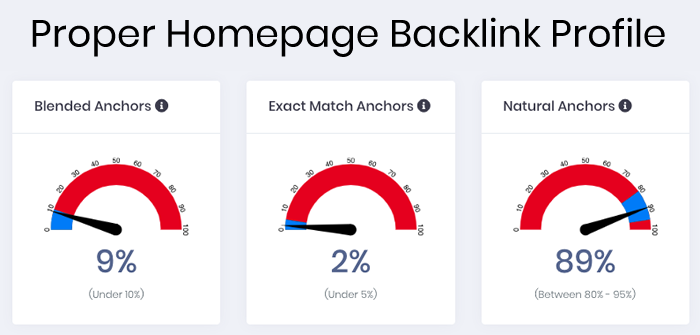
Many people make the mistake of aggressively trying to target key phrases on the homepages. But, you’ll have more success if you build branded and WebsiteName.com anchors to your homepage.
The inner page has its own unique anchor distribution. These pages can include anything from a long-form blog post (SEO power page), services page, or product page.
You can start aggressively targeting key phrases on your inner pages once you’ve built proper brand authority on the homepage.
There are two anchor text ratios for inner pages.
First, take the average of all #1 ranked pages across all niches and build a link map to match the ratio of all of those pages. Or, take the average anchor text distribution of any or all of the top 10 ranked pages for your main key phrase.
See what we mean below.
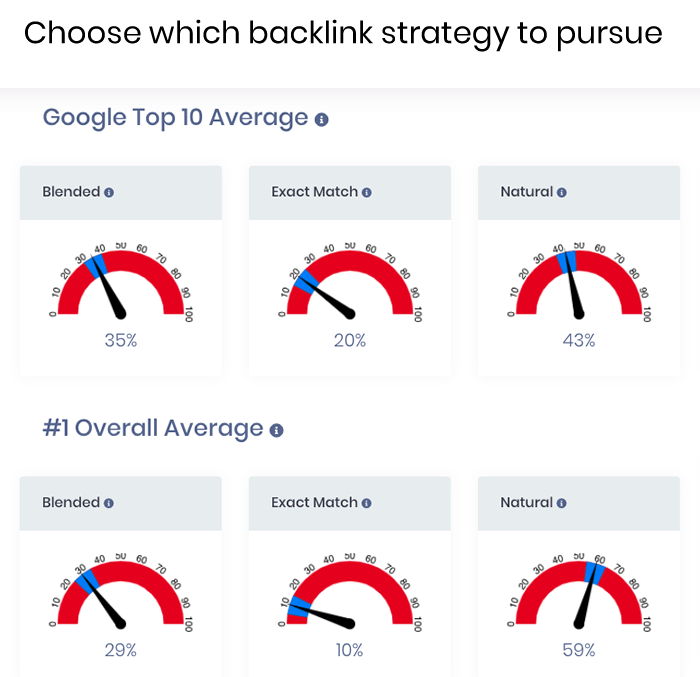
If you build your link map to match the top 10 ranked pages, SEOJet will let you customize the list to meet your individual needs. We let you pick and choose which top 10 pages you want to match. You can click “ignore” for any results you don’t want to see.
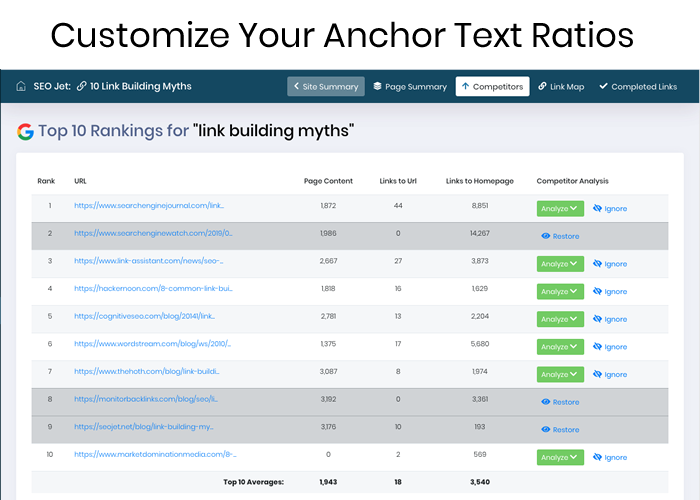
Using the top 10 averages is riskier. This is because you’re comparing your backlink profile against smaller sample sizes. We understand that every niche is a little different so using this option can often help move the needle when your rankings become stagnant.
Using the top 10 results will also give you a better idea of how many backlinks you need to rank.
How would you like to see your competition’s backlink profile?
All you have to do is download the backlinks of everyone in the top 10 results. Then, go through each of their anchor texts and categorize them. You’ll be able to group the anchor text categories and then do the calculations to know what their profile looks like.
Or, you can let SEOJet automatically do it for you!
One of the cool tools inside of SEOJet is the competitor analysis tool. You can check the backlink profile of each of the top 10 ranked pages to see how your website stacks up to them.
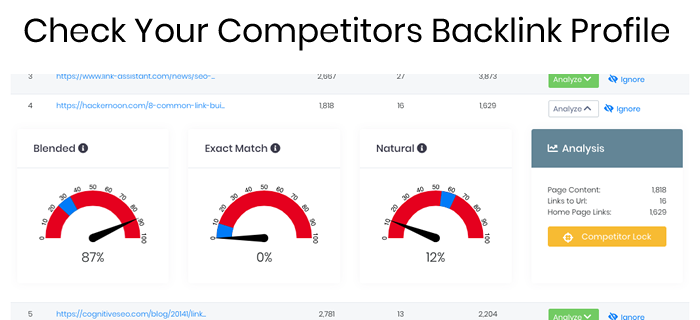
This becomes extremely useful for niches or categories where those in the top 10 are different than normal.
As soon as you enter any page of your website into SEOJet, the software will automatically scan your backlink profile and let you know how natural your ratio looks compared to all other #1 ranked pages.
You can then do a Google top 10 comparison for your main key phrase to see how your profile compares to them. SEOJet will show you each of the top 10 search results with their backlink data and gauges so you can make informed decisions.
With our tool, you can do a deep dive into any website in the top 10 for a side-by-side comparison of backlinks.
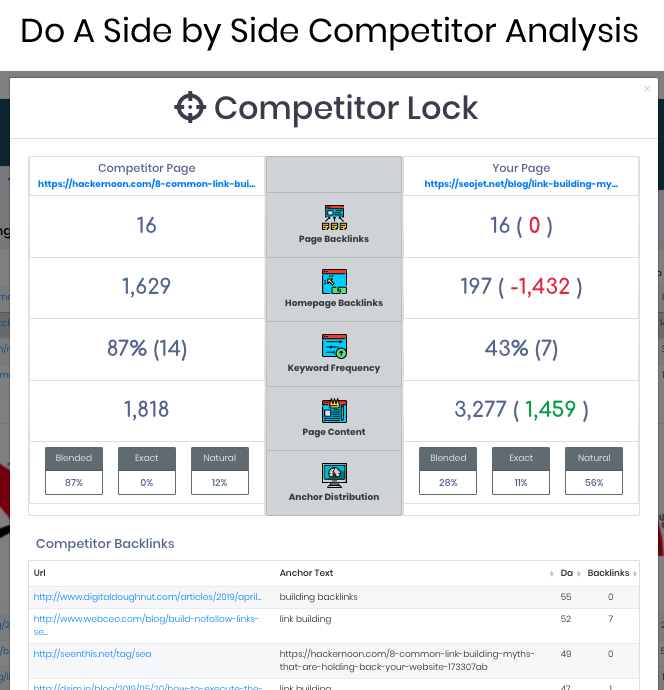
SEOJet offers a built-in anchor text generator, which we call a “link map.” You can use this tool to start creating new anchor texts to close the gap between you and the competition.
The anchor text distribution tool also tells you exactly which anchor texts you need to match a top-ranked profile.
We generate the suggested anchor text for you to keep your backlink profile looking clean. SEOJet truly makes the link-building process as simple as filling in the blanks.
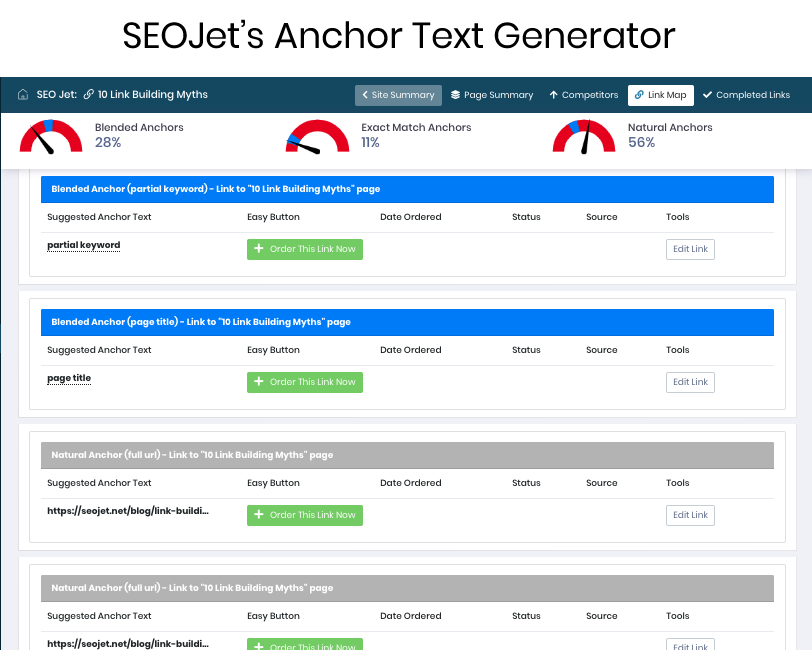
Without a doubt, backlinks are one of the top-ranking factors on Google. In order to create backlinks effectively, you need to understand the use of anchor texts. Adding a ton of new backlinks won’t help your SEO if the anchor texts aren’t done right.
In order to be successful, you need an anchor text strategy that looks natural while matching some of the other sites ranking in the top 10 of Google.
Researching anchor texts manually could take forever. That’s why SEOJet is offering you this sophisticated software to plan out a good anchor text ratio strategy in minutes. It can help you improve ranking quicker and with fewer backlinks than your competitors.
Are you ready to set yourself up for success?